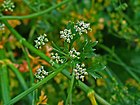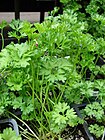Note: This is a project under development. The articles on this wiki are just being initiated and broadly incomplete. You can Help creating new pages.
Difference between revisions of "Petroselinum crispum"
| (One intermediate revision by one other user not shown) | |||
| Line 1: | Line 1: | ||
| − | + | [[File:Petroselinum crispum Neapolitanum 0zz.jpg |thumb|right|'''Petroselinum crispum''']] | |
| + | '''Petroselinum crispum''' is a species of flowering plant in the family Apiaceae that is native to the central and eastern Mediterranean region. It is naturalized elsewhere in Europe and is widely cultivated as an herb, and a vegetable. | ||
==Uses== | ==Uses== | ||
| − | {{Uses|}}, {{Uses|}}, {{Uses| | + | {{Uses|Gastrointestinal disorders}}, {{Uses|Inflammation}}, {{Uses|Halitosis}}. |
==Parts Used== | ==Parts Used== | ||
| − | {{Parts Used|}}, {{Parts Used| | + | {{Parts Used|Seeds}}, {{Parts Used|Leaves}}. |
==Chemical Composition== | ==Chemical Composition== | ||
| − | <ref name="chemical composition"/> | + | Petroselinum crispum (Mill) flat leaves specimens were isolated and identified the flavonoids apigenin (1), apigenin-7-O-glucoside or cosmosiin (2), apigenin-7-O-apiosyl-(1 --> 2)-O-glucoside or apiin (3) and the coumarin 2",3"-dihydroxyfuranocoumarin or oxypeucedanin hydrate (4).<ref name="chemical composition"/> |
==Common names== | ==Common names== | ||
| − | {{Common names | + | {{Common names|kn=|ml=|sa=|ta=|te=|hi=|en=Parsley}} |
==Properties== | ==Properties== | ||
Reference: Dravya - Substance, Rasa - Taste, Guna - Qualities, Veerya - Potency, Vipaka - Post-digesion effect, Karma - Pharmacological activity, Prabhava - Therepeutics. | Reference: Dravya - Substance, Rasa - Taste, Guna - Qualities, Veerya - Potency, Vipaka - Post-digesion effect, Karma - Pharmacological activity, Prabhava - Therepeutics. | ||
===Dravya=== | ===Dravya=== | ||
| + | |||
===Rasa=== | ===Rasa=== | ||
| − | |||
===Guna=== | ===Guna=== | ||
| Line 29: | Line 30: | ||
==Habit== | ==Habit== | ||
| − | {{Habit|}} | + | {{Habit|Herbs}} |
==Identification== | ==Identification== | ||
===Leaf=== | ===Leaf=== | ||
| − | {{Leaf|||}}<ref name="Leaf"/> | + | {{Leaf|Simple||Leaves 10–25 cm long with numerous 1–3 cm leaflets}}<ref name="Leaf"/> |
===Flower=== | ===Flower=== | ||
| − | {{Flower||||}} | + | {{Flower|Bisexual||Yellow to yellowish-green||2 mm diameter}} |
===Fruit=== | ===Fruit=== | ||
| − | {{Fruit||| | + | {{Fruit|Simple Fruit|Ovoid|2–3 mm long||}} |
===Other features=== | ===Other features=== | ||
| Line 48: | Line 49: | ||
==Mode of Propagation== | ==Mode of Propagation== | ||
| − | {{Propagation|}} | + | {{Propagation|Seeds}}. |
==How to plant/cultivate== | ==How to plant/cultivate== | ||
| − | <ref name="How to plant/cultivate"/> | + | Parsley grows best in moist, well-drained soil, with full sun. It grows best between 22–30 °C (72–86 °F), and usually is grown from seed.<ref name="How to plant/cultivate"/> |
==Commonly seen growing in areas== | ==Commonly seen growing in areas== | ||
| − | {{Commonly seen| | + | {{Commonly seen|Lowland forest}}. |
==Photo Gallery== | ==Photo Gallery== | ||
<gallery class="left" caption="" widths="140px" heights="140px"> | <gallery class="left" caption="" widths="140px" heights="140px"> | ||
| − | + | File:Petroselinum crispum 004.JPG | |
| + | File:Petroselinum crispum seeds.jpg | ||
| + | File:Starr 070906-8878 Petroselinum crispum.jpg | ||
| + | File:Root z08 petersil.JPG | ||
</gallery> | </gallery> | ||
==References== | ==References== | ||
| + | |||
<references> | <references> | ||
| + | <ref name="chemical composition">[https://www.ncbi.nlm.nih.gov/pubmed/21834233#:~:text=From%20the%20aqueous%20extract%20(Pc,or%20oxypeucedanin%20hydrate%20(4). Chemical composition]</ref> | ||
| − | <ref name=" | + | <ref name="Leaf">[https://en.wikipedia.org/wiki/Parsley Morphology]</ref> |
| − | + | <ref name="How to plant/cultivate">[https://en.wikipedia.org/wiki/Parsley Cultivation Details]</ref> | |
| − | |||
| − | <ref name="How to plant/cultivate">[ | ||
| − | |||
</references> | </references> | ||
==External Links== | ==External Links== | ||
| − | * [ ] | + | * [https://commons.wikimedia.org/wiki/Petroselinum_crispum Petroselinum crispum on wikimedia commons] |
| − | + | ||
| − | + | ||
[[Category:Herbs]] | [[Category:Herbs]] | ||
| − | [[Category: | + | [[Category:Apiaceae]] |
Latest revision as of 15:59, 30 June 2020
Petroselinum crispum is a species of flowering plant in the family Apiaceae that is native to the central and eastern Mediterranean region. It is naturalized elsewhere in Europe and is widely cultivated as an herb, and a vegetable.
Contents
- 1 Uses
- 2 Parts Used
- 3 Chemical Composition
- 4 Common names
- 5 Properties
- 6 Habit
- 7 Identification
- 8 List of Ayurvedic medicine in which the herb is used
- 9 Where to get the saplings
- 10 Mode of Propagation
- 11 How to plant/cultivate
- 12 Commonly seen growing in areas
- 13 Photo Gallery
- 14 References
- 15 External Links
Uses
Gastrointestinal disorders, Inflammation, Halitosis.
Parts Used
Chemical Composition
Petroselinum crispum (Mill) flat leaves specimens were isolated and identified the flavonoids apigenin (1), apigenin-7-O-glucoside or cosmosiin (2), apigenin-7-O-apiosyl-(1 --> 2)-O-glucoside or apiin (3) and the coumarin 2",3"-dihydroxyfuranocoumarin or oxypeucedanin hydrate (4).[1]
Common names
| Language | Common name |
|---|---|
| Kannada | |
| Hindi | |
| Malayalam | |
| Tamil | |
| Telugu | |
| Marathi | NA |
| Gujarathi | NA |
| Punjabi | NA |
| Kashmiri | NA |
| Sanskrit | |
| English | Parsley |
Properties
Reference: Dravya - Substance, Rasa - Taste, Guna - Qualities, Veerya - Potency, Vipaka - Post-digesion effect, Karma - Pharmacological activity, Prabhava - Therepeutics.
Dravya
Rasa
Guna
Veerya
Vipaka
Karma
Prabhava
Habit
Identification
Leaf
| Kind | Shape | Feature |
|---|---|---|
| Simple | Leaves 10–25 cm long with numerous 1–3 cm leaflets |
Flower
| Type | Size | Color and composition | Stamen | More information |
|---|---|---|---|---|
| Bisexual | Yellow to yellowish-green | 2 mm diameter |
Fruit
| Type | Size | Mass | Appearance | Seeds | More information |
|---|---|---|---|---|---|
| Simple Fruit | Ovoid | 2–3 mm long | {{{6}}} |
Other features
List of Ayurvedic medicine in which the herb is used
Where to get the saplings
Mode of Propagation
How to plant/cultivate
Parsley grows best in moist, well-drained soil, with full sun. It grows best between 22–30 °C (72–86 °F), and usually is grown from seed.[3]
Commonly seen growing in areas
Photo Gallery
References
External Links
- Ayurvedic Herbs known to be helpful to treat Gastrointestinal disorders
- Ayurvedic Herbs known to be helpful to treat Inflammation
- Ayurvedic Herbs known to be helpful to treat Halitosis
- Herbs with Seeds used in medicine
- Herbs with Leaves used in medicine
- Herbs with common name in English
- Habit - Herbs
- Index of Plants which can be propagated by Seeds
- Herbs that are commonly seen in the region of Lowland forest
- Herbs
- Apiaceae




